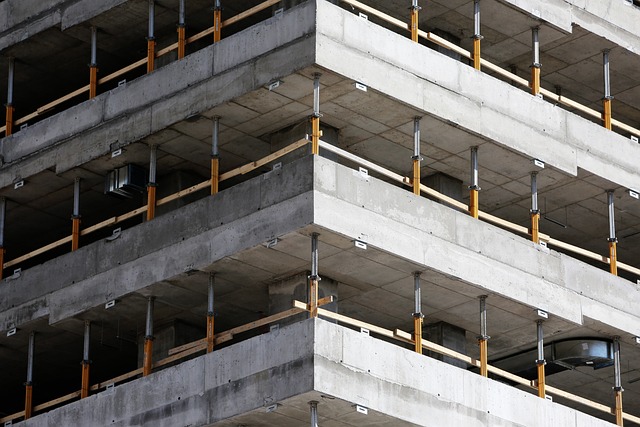Concrete repair is crucial for maintaining foundation structural integrity, preventing costly damage from erosion, poor construction, moisture, tree roots, and extreme weather. Regular inspections and proactive maintenance using advanced techniques like polymers, resins, and fiber-reinforced composites ensure long-term stability and longevity of buildings. Case studies highlight successful restoration projects, emphasizing the importance of tailored repair methods based on local geological factors for robust, sustainable foundations.
Foundation structural integrity is a cornerstone of any sturdy structure. This article delves into the intricacies of maintaining and restoring this critical element, focusing on concrete repair as a key strategy. We explore common causes of foundation damage, advanced repair techniques, long-term preventative measures, and highlight successful case studies. Understanding these aspects empowers property owners and professionals alike to safeguard their investments through effective concrete repair solutions.
Understanding Foundation Structural Integrity

Foundation structural integrity is a critical aspect of any building’s overall stability and longevity. It refers to the strength, stability, and durability of a structure’s foundation, which bears the weight of the entire building. Ensuring this integrity involves several key elements. One crucial component is regular concrete repair, as cracks or deteriorations in concrete can compromise the foundation’s ability to support the structure.
Proper maintenance includes regularly inspecting the foundation for any signs of damage and addressing issues promptly. Concrete repair techniques such as patching, sealing, or replacing sections of damaged concrete help maintain structural integrity. By taking proactive measures, homeowners and builders can prevent more severe foundation problems down the line, ensuring the safety and stability of the building for years to come.
Common Causes of Foundation Damage

Foundation damage can arise from various factors, often leading to costly concrete repair expenses. One of the primary causes is soil erosion, especially in areas with high water tables or excessive rainfall. As the ground beneath shifts and settles unevenly, it exerts differential stress on the foundation, causing cracks and misalignments. Another common issue is poor initial construction, including inadequate reinforcing bars, incorrect concrete mix designs, or subpar workmanship. These initial defects can weaken the foundation over time, making it susceptible to damage from environmental factors like moisture intrusion and shifting soil.
Additionally, tree roots can infiltrate cracks in the foundation, causing further weakening and potential structural compromise. Extreme temperature fluctuations and seismic activities are also significant contributors to foundation damage. Concrete repair becomes necessary when these issues lead to visible cracks, settlement, or even structural instability, requiring expert intervention to ensure the longevity of the structure.
The Role of Concrete Repair in Restoring Integrity

Concrete repair plays a pivotal role in restoring structural integrity to foundations that have suffered damage or degradation over time. When concrete structures, such as those found in buildings and infrastructure, begin to show signs of cracking, spalling, or erosion, prompt intervention is crucial. Skilled professionals employ various techniques and materials to patch up these weaknesses, ensuring the long-term stability and safety of the foundation.
The process involves assessing the extent of damage, removing any unstable or weakened concrete, and replacing it with a suitable repair compound. This not only fixes the immediate issue but also prevents further deterioration by sealing entry points for moisture and corrosive substances that can accelerate concrete decay. Effective concrete repair is essential in maintaining the structural integrity of foundations, preserving the overall quality and lifespan of the built environment.
Advanced Techniques for Effective Concrete Repairs

In the realm of foundation structural integrity, effective concrete repairs are paramount. Advanced techniques have emerged to address the challenges associated with damaged concrete structures, ensuring longevity and stability. One such innovative approach involves the use of advanced polymers and resins that can penetrate deep into cracks and crevices, providing a powerful bond and repair mechanism. These modern solutions offer superior strength and flexibility compared to traditional methods, making them ideal for complex repairs in demanding environments.
Additionally, fiber-reinforced composites have revolutionized concrete repair processes. By incorporating high-strength fibers like carbon or glass into the repair mixture, the overall structural integrity is significantly enhanced. This technique allows for the restoration of load-bearing capabilities and prevents further deterioration, ensuring the foundation’s stability over time. These advanced techniques not only cater to the immediate repair needs but also contribute to the long-term sustainability and performance of concrete structures.
Long-Term Solutions to Prevent Future Damages

To ensure the long-term structural integrity of a foundation, proactive measures and concrete repair techniques are essential. Regular inspections are the first step; identifying potential issues early allows for more effective prevention. By assessing factors like ground movement, moisture levels, and existing damage, professionals can implement tailored solutions. One such solution is the use of advanced epoxy injections to fill cracks and strengthen weak spots in the foundation. This method not only stops further deterioration but also enhances the overall stability of the structure.
Additionally, reinforcing steel bars or mesh can be incorporated into concrete repair processes to increase tensile strength and compressive resistance. These long-term solutions are designed to withstand various environmental factors, ensuring the foundation remains robust for years to come. This proactive approach to concrete repair is crucial in mitigating future damages and preserving the structural integrity of buildings.
Case Studies: Successful Foundation Restoration Projects

Successful foundation restoration projects offer valuable insights into the intricacies of structural integrity. Case studies from around the globe highlight various challenges, from settlement and heave to moisture infiltration and corrosion. One notable example involves a historic building in a coastal city, where advanced concrete repair techniques were employed to address extensive damage caused by erosion and salt water intrusion. Engineers utilized specialized epoxy injections to fill micro-cracks, enhancing the foundation’s load-bearing capacity.
Another successful project focused on a modern multi-story car park, suffering from significant settlement issues due to poor soil conditions. Through meticulous planning and implementation, a deep foundation solution was adopted, utilizing pile reinforcement to stabilize the structure. These projects demonstrate the importance of understanding local geological factors, adopting tailored repair methods, and ensuring long-term sustainability in restoring structural integrity.
